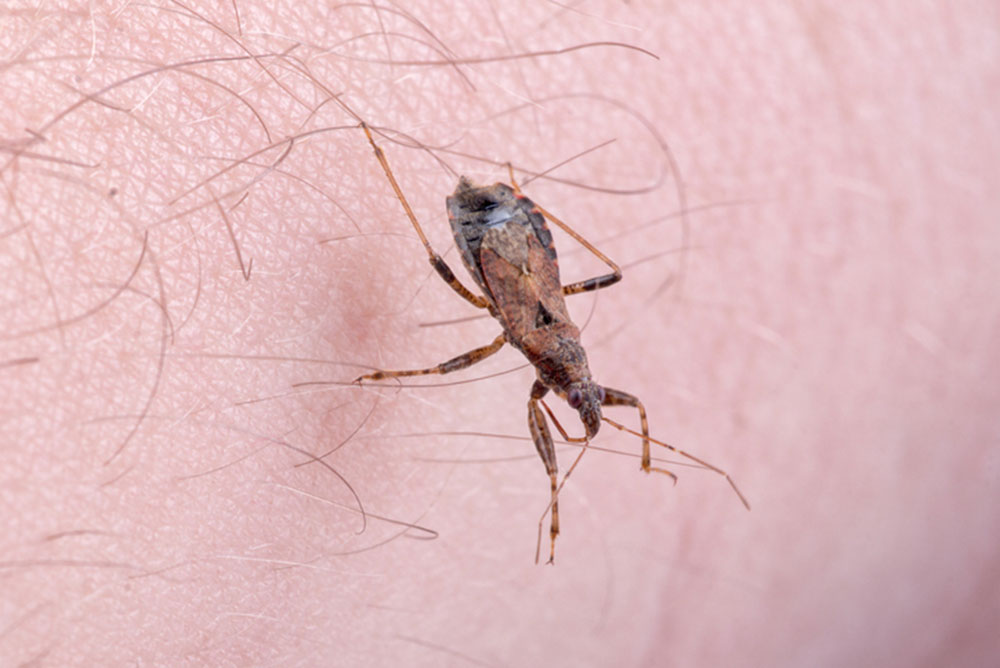
iStock
By Mary Carpenter
TO AVOID Chagas disease, I learned when living for a few months in Venezuela, don’t sleep in mud or thatched huts. In substandard housing — officially, homes of poverty—triatomine bugs, called “kissing bugs,” which are the vectors, emerge at night and infect humans with the T.cruzi parasites that cause Chagas.
Travelers in Latin America, especially in Brazil, should also avoid unpasteurized acai juice, or any sugar cane juice, because triatomine bugs can contaminate the fruit or cane during processing and storage. The bug earns its nickname because it often bites an exposed area of the skin or mucosa membrane (notably around the lips, also the eyes) and then defecates nearby, after which victims smear the bug’s feces into the bite.
In the U.S., kissing bugs are present in Delaware and Maryland, as well as in the southern United States —but not all triatome bugs are infected with T.cruzi. Even if a bug carries the infection, the likelihood of getting Chagas disease from a single triatomine bug in the U.S. is low, according to the CDC. Most of the 300,00 in the United States people living with Chagas disease had the infection before emigrating from Latin American countries, where chronic Chagas affects anywhere from six to eleven million people.
The Kissing Bug, a new book by Chilean author Daisy Hernandez, describes her childhood fear of the triatomine bug —along with “’the great epi divide,” medicine’s neglect of illnesses that mostly affect people in developing countries. Chagas is on the list of “diseases of poverty” — of which the “Big Three,” responsible for 10% of global mortality, are tuberculosis, HIV and malaria. Diagnoses of these diseases have decreased during the Covid pandemic, but public health experts fear that all are likely on the rise.
As the most prevalent communicable tropical disease in Latin America, Chagas disease appears on the WHO list of “neglected tropical diseases” and other lists of “neglected parasitic infections”—helping to bring attention and resources to stopping its spread. Case numbers for Chagas disease increase each year—in the Amazon region, causing disability in infected people and more than 10,000 deaths per year.
Chagas is rarely the result of a single encounter. Following a bite, the first visible sign can be swelling, called a chagoma, or rash; or purplish swelling or conjunctivitis in one eye. The acute infection, which can also cause mild fever, aches and other symptoms, responds to anti-parasitic drugs. Left untreated, active infection can progress to the chronic stage.
T.Cruzi parasites can live in the human body for years or decades, causing chronic Chagas, which in 30% of cases leads to severe heart and gastrointestinal disease. Ten percent of cases result in death, most often due to heart disease.
The parasites that cause Chagas disease (also known as American trypanosomiasis) belong to the same family of pathogens–trypanosomatids—as those responsible for African Sleeping Sickness (African Trypanosomiasis), transmitted by the tsetse fly; and Leishmaniasis, which causes skin sores and can affect internal organs, transmitted by sand flies, also primarily in Africa. Over time, so many people have become tolerant of these parasites that the majority of those contaminated are considered “healthy carriers.”
Of the Big Three diseases of poverty, tuberculosis is the leading cause of death from infectious diseases around the world—and when occurring in tandem with HIV, each can make the other infection more virulent. Like Chagas, TB has two forms: active and latent. Latent TB— in someone whose immune system keeps a reduced level of bacteria in the body and thus prevents active infection—is not contagious and causes no symptoms.
But of those individuals with latent TB, 5-10% will develop active TB disease at some point in their lifetime. In 2019, the U.S. reported fewer than 1,000 active TB disease cases, and 13 million cases of latent TB.
Also like Chagas, TB rarely occurs after a single or brief encounter. With TB, the bacteria spread through the air, and most often infect those with repeated exposure to someone with active disease, who is coughing or sneezing. Infection can occur either soon after exposure, before the immune system revs up to combat the bacteria, or at any point afterwards, even years later, during periods of weakened immunity. Anyone who has been exposed to active TB is a candidate for one of several TB treatments.
Protection against TB first requires awareness of infected people around you. To protect against Chagas disease in the U.S., the key is to identify the bugs, also known as the eastern bloodsucking conenose bug, a member of the family called assassin bugs. Most adults range in size from ¾ to 1 ¾ inches in length, have an elongated cone-shaped head and have red-orange banding on their stomach.
With a suspected triatomine bug—as with the deer tick that carries Lyme disease—a lab or health provider must make the identification. For collection, avoid touching or squashing the bug by placing a container on top and sliding the bug inside; and then fill the container with rubbing alcohol or freeze the bug in the container until it can be identified.
But the advice I kept getting during my youthful months in 1970s Latin America, usually said with a wink at the innuendo: be careful where you spend the night away from home.
—Mary Carpenter regularly reports on topical subjects in health and medicine.

This is good to know about. I had no idea there were kissing bugs in this region. Thank you.